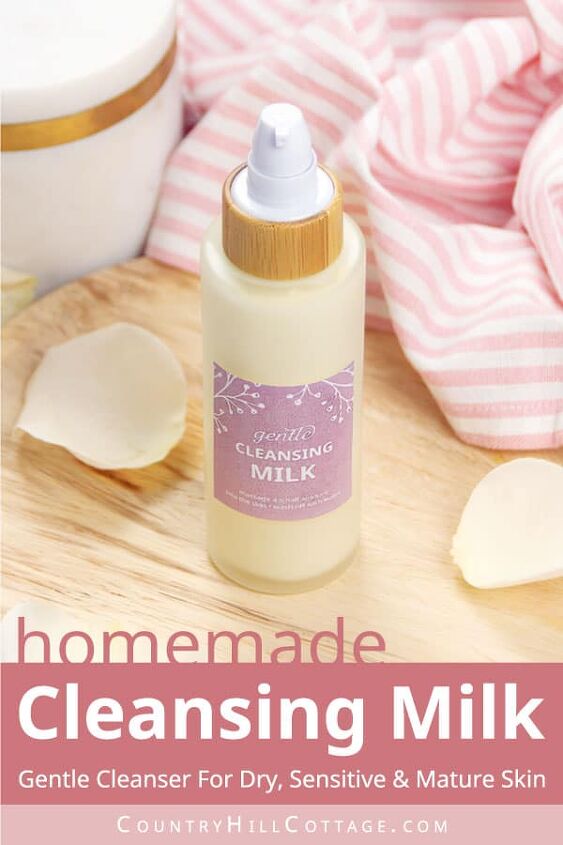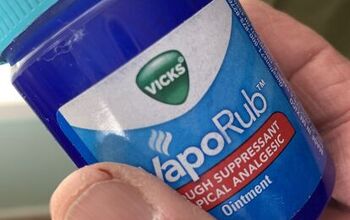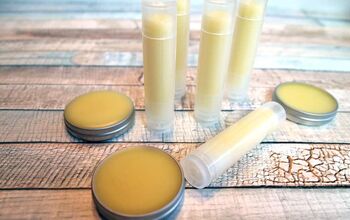DIY Cleansing Milk

This DIY cleansing milk recipe is the perfect homemade facial cleanser for dry, sensitive, and mature skin. The milk cleanser is incredibly gentle and has a luxurious texture. The product melts away make up and will leave your skin feeling moisturized and nourished.
Disclosure: This post contains affiliate links, meaning, at no additional cost to you, we will earn a small commission if you click through and make a purchase. Learn more
Table of Contents
The best cleansing milk recipe
A few months ago, our lovely reader Dawn asked for a gentle cleanser recipe for sensitive and mature skin. I’m happy to comply with Dawn’s request and share this mild DIY milk cleanser recipe.
This milky cleansing lotion is an excellent DIY cleanser for mature, dry, sensitive, and normal skin. It cleanses and moisturizes in a single step and won’t leave your skin feeling tight or stripped.
The post is a bit lengthy as I wanted to create an in-depth resource with all details on how to make and use homemade cleansing milk and the benefits this nourishing cleanser has to offer.
And don’t forget to try our exfoliating cleansing balm, vanilla cleansing bars, and this rose cleansing balm, too.
Cleansing Milk Recipe
This DIY cleansing milk recipe is the perfect homemade facial cleanser for dry, sensitive, and mature skin. The milk cleanser is incredibly gentle and has a luxurious texture. The product melts away make up and will leave your skin feeling moisturized and nourished.
PREP TIME
1 hour
TOTAL TIME
1 hour
DIFFICULTY
intermediate
Materials
Phase A (Water Phase)- 1/2 cup / 120 g / 4.2 oz distilled water
- 1 tsp / 6 g / 0.2 oz Succrose Cocoate (Sanfttensid)
- 2 1/4 tbsp / 30 g oil / 1 oz jojoba oil
- 1 tbsp / 10 g / 0.3 oz Montanov 68
- 1/2 tsp / 1 g / 0.4 oz xanthan gum
- 1/2 tbsp / 10 g / 0.35 oz glycerin
- 1/4 tsp / 1 g / 0.4 oz PhytoElastin or elastin (optional)
- 1/2 tsp / 2 g / 0.07 oz / 40 drops preservative (I used Preservative Eco / Geogard ECT)
- 8 drops lactic acid
Tools
- glass beakers
- large pot
- glass stirrer
- milk frother or mini mixer
- paper towels
- kitchen gloves
- 7-oz glass pump bottle
Instructions
- Cooldown phase. Add the glycerin into a small beaker or glass. Sprinkle the xanthan gum overtop and incorporate with a milk frother or until the xanthan gum has completely dissolved. The mixture will look cloudy, and no traces of dry powder should be visible. Add the PhytoElastin/elastin (if using) and incorporate. Set aside.
- Water phase. Add the distilled water and sucrose cocoate into a heatproof glass beaker or glass jar.
- Oil phase. Add the jojoba oil and Montanov 68 into a separate glass beaker or jar.
- Warm the oil and water phases. In a large pot, bring water to a mild simmer (barely any bubbles or steam). Maintain the soft simmer and reduce the heat if necessary (the water must not be boiling). Place both beakers into the water bath and heat until the Montanov 68 has melted. Stir occasionally to help along the melting process.
- Create the emulsion. Once the emulsifier is liquid, take both phases out of the water and place on a kitchen towel to catch moisture outside the beakers. Wear kitchen gloves when handling the beakers, and be mindful of hot steam. Using a milk frother or mini mixer, start mixing the oil phase. VERY SLOWLY pour in the water phase while continuously mixing. The mixture will triple or quadruple in volume and will become cream-colored, opaque, and thick.
- Finish the milk cleanser. Once the emulsion has cooled to room temperature, add the cooling phase from step 1 and incorporate well. Add the preservative and lactic acid and give the cleansing milk a good stir. Transfer the cleansing milk into a glass pump bottle.
The problem with many cleansers
Do you know that dry, itchy feeling after using a facial cleanser? It’s an indication that the cleanser is too harsh. Too harsh means that the cleanser is removing more than it should. What does that mean?
In theory, a cleanser should only remove excess oils and sebum plus the dirt and grime of the day.
But harsh cleanser will also strip the skin of its good oils and natural moisture. The repeated use of harsh face cleansers will disrupt and weaken the skin barrier, which can lead to irritation, itchiness, redness, dryness, and skin sensitivity.
Why are some cleansers too harsh? That usually depends on the type of cleansing agent, the surfactant. Sulfates, which are often used in cleansers and shampoos, can be extremely harsh on sensitive and dry skin and strip the skin of its natural sebum layer.
Not so this homemade cleansing milk!
What is cleansing milk?
Cleansing milk is a liquid face cleanser and has a milky texture and appearance. This type of cleanser is incredibly lightweight and gentle yet still highly effective to free your face from grime, sweat, + makeup and helps to keep the skin free of impurities.
Formulation-wise, cleansing milk is an emulsion. The skincare product is made by combining a water phase (= the water-soluble ingredients) with an oil phase (= the oil-soluble ingredients) with the help of an emulsifying agent.
How does cleansing milk work?
As I mentioned, cleansing milk is a water-oil emulsion. The oil part attracts skin oils, sweat, and make up, and the water part makes it possible to wash this stuff away.
Cleansing milk benefits
Now that we know what cleansing milk is and how this DIY face cleanser works, let’s recap the benefits of cleansing milk:
- Gentle: Cleansing milk is formulated with mild ingredients and cleanses gently.
- Non-drying: The hydrating formula ensures that your skin feels moisturized and doesn’t dry out.
- Soothing: If conventional face cleansers cause irritation, you’d be pleased to know that my milky cleanser is calming and soothing.
- Nourishing: This homemade cleansing milk doesn’t strip the skin. Instead, it contains emollient + refatting ingredients that leave your face feeling soft and refreshed.
DIY cleansing milk ingredients
This homemade milk cleanser recipe has all kinds of good-for-you materials in it. The key ingredients that make this DIY milk cleanser so gentle and nourishing are:
- Distilled water acts as a solvent for the other ingredients and provides moisture. If distilled water isn’t available, use boiled, cooled bottled water.
- Jojoba oil mimics the natural oils in human skin (sebum) and is an excellent ingredient to support skin health. The oil helps to maintain moisture, and its anti-inflammatory properties can soothe various skin ailments. Despite the name, jojoba oil is a liquid plant wax and is considered non-comedogenic, meaning it doesn’t clog pores. You can sub jojoba oil with another liquid plant oil if preferred.
- Phytoelastin (optional), a plant version of elastin, helps to moisturize, revitalize, and nourish the skin and improve fine lines and wrinkles.
- Glycerin is a moisturizer and pulls water into the skin. It also helps to dissolve the xanthan gum.
- Xanthan gum helps to thicken and stabilize the formula.
- Montanov 68 is the emulsifier and ensures that the oil and water phases bind and stay together. The ingredient also creates luxurious creaminess, reduces transepidermal water loss (TEWL), and has excellent refatting qualities.
- Sucrose Cocoate is an ultra-mild, ECOCERT-approved surfactant and refatting agent made from sugar beets and coconut oil. The ingredient provides a gentle cleansing action and has an emollient effect.
- Lactic acid is required to adjust the pH of the cleanser. The pH of this DIY cleansing milk ranges between 4.5 to 5.5, which is in harmony with the pH of our skin.
- Preservative: We need a preservative to protect our water-based cleansing milk from mold, bacteria, and other microorganisms. I used Preservative Eco (Geogard ECT), which is an eco-friendly preservative.
Herb-infused jojoba oil
If you want to further increase the skincare benefits of the cleanser, infuse the jojoba oil with herbs. Try one of these ideas:
- cornflower infused oil
- elderflower infused oil
- lavender-infused oil
- dandelion infused oil (from Everything Pretty)
- calendula infused oil (via A Life Adjacent)
- plantain infused oil (by Soap Deli News)
As I mentioned, you may substitute the jojoba oil for any other liquid oil you like or have available.
What is PhytoElastin?
Elastin is one of the most abundant proteins in the skin and body. It provides structure, and elasticity, making the skin looking youthful and plump. Unfortunately, elastin decreases with age, which reduces elasticity and leads to fine lines and wrinkles.
Including products with elastin in your skincare can help to lessen and delay signs of premature skin aging.
Elastin is often sourced from fish. You can use regular elastin if your cleansing milk doesn’t need to be vegan or vegetarian.
In case you prefer vegan cleansing milk, try this plant-based elastin (PhytoElastin), which is derived from yeast.
Another idea is to prepare the cleansing milk with hydrolyzed oat protein, which helps retain moisture and imparts a soft, velvety skin feel. Rich in amino acids, it also replenishes your skin with essential nutrients.
Of course, you can also skip this ingredient – the cleansing milk will still turn out beautifully.
Where to buy sucrose cocoate
Sucrose cocoate is sometimes called Sanfttensid and available at the following shops:
- US: [url=https://www.makingcosmetics.com/Sucrose-Cocoate_p_109.html?locale=en
Enjoyed the project?
The author may collect a small share of sales from the links on this page.
























Comments
Join the conversation